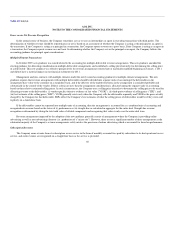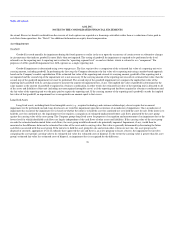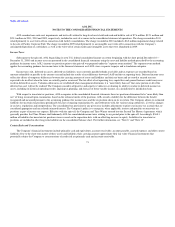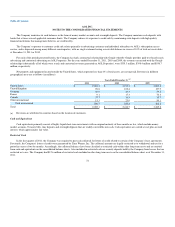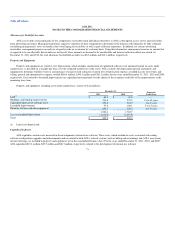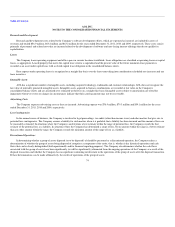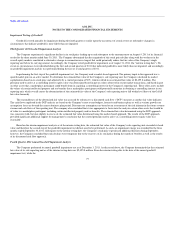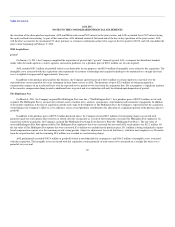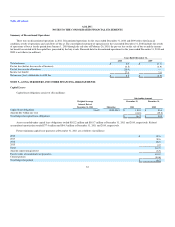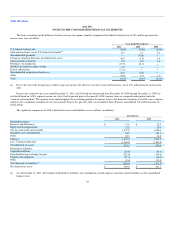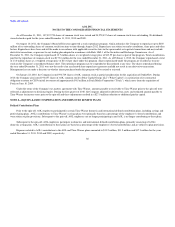America Online 2011 Annual Report Download - page 82
Download and view the complete annual report
Please find page 82 of the 2011 America Online annual report below. You can navigate through the pages in the report by either clicking on the pages listed below, or by using the keyword search tool below to find specific information within the annual report.
Table of Contents
AOL INC.
NOTES TO THE CONSOLIDATED FINANCIAL STATEMENTS
Company's stock price declined, actual operating income slightly exceeded its projections, and the Company's long-term projections did not materially change
during that period. Given these trends, management determined that it was appropriate to adjust the Company's market capitalization with a control premium
of 70%, which resulted in an estimated fair value for the Company's sole reporting unit of $2,318.1 million as of December 1, 2011. The premium used to
arrive at a controlling interest equity value was determined based in part on values observed in recent market transactions, and based in part on other assets
that a marketplace participant could benefit from in acquiring a controlling interest in our reporting unit, which overall causes the determination of the
estimated fair value of the Company's sole reporting unit to fall within level three of the GAAP fair value hierarchy.
The reasonableness of the determined fair value was assessed by reference to another fair value indicator, a discounted cash flow approach. The cash
flows employed in the DCF analysis are based on the Company's most recent budgets, forecasts and business plans as well as various growth rate assumptions
for years beyond the current business plan period. Discount rate assumptions are based on an assessment of the risk inherent in the future revenue streams and
cash flows of the reporting unit. Based on the decline in the Company's stock price from the 2010 impairment analysis to the December 2011 impairment
analysis, management concluded that it was appropriate to increase the discount rates used from 2010 to December 2011. The company also concluded that it
was appropriate to factor into the analysis certain other assets that would be of value to a marketplace participant, including certain intellectual property and
tax benefits. The estimated fair value determined using the DCF approach was consistent with, but also slightly in excess of, the estimated fair value
determined using the market-based approach. The results of the DCF approach provided significant additional support for management's conclusion that the
control premium used to arrive at a controlling interest equity value was reasonable.
Based on the Company's annual impairment analysis as of December 1, 2011, the estimated fair value of the Company's sole reporting unit exceeded its
book value and therefore the second step of the goodwill impairment test did not need to be performed. As such, no impairment charge was recorded during
the fourth quarter of 2011.
Sensitivity Analysis—2011 Goodwill Impairment Tests
As the market-based approach is based in part on market capitalization, volatility in the stock price could have a significant impact on the estimated fair
value of the sole reporting unit. If the estimated fair value of the Company's reporting unit had been hypothetically lower by 5% as of the date of the interim
or annual impairment test, the fair value of the Company's reporting unit in both cases would have still exceeded its book value. However, if the estimated fair
value of the Company's reporting unit had been hypothetically lower by 10% as of the date of the interim or annual impairment test, the book value of the
Company's reporting unit in both cases would have exceeded fair value. If the book value of the Company's reporting unit had been greater than fair value, the
second step of the goodwill impairment test would have been required to be performed to determine the implied fair value of goodwill, and would likely have
resulted in a significant goodwill impairment charge.
2010 and 2009 Goodwill Impairment Analyses
The Company performed a goodwill impairment analysis based on certain triggering events occurring during the second quarter of 2010. As a result,
the Company recorded an impairment charge of $1,414.4 million for the three months ended June 30, 2010. In connection with the annual goodwill
impairment analysis performed during the fourth quarter of 2010, the Company determined that the fair value of its sole reporting unit exceeded its book
value. As a result, the second step of the goodwill impairment test did not need to be performed; and therefore no additional charge was incurred during 2010.
78


